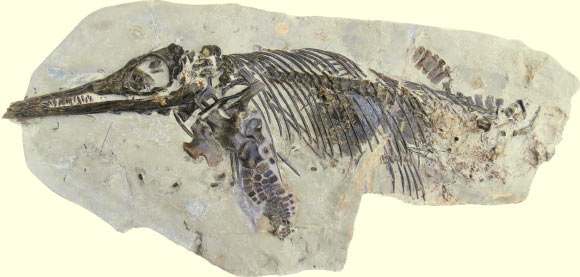Paleontologists Dean Lomax of the University of Manchester, UK, and Prof Judy Massare of Brockport College in New York have discovered a new species of ichthyosaur that lived in what is now the United Kingdom during the Pliensbachian stage of the early Jurassic period, between 189 and 182 million years ago.
The newly-discovered species has been named Ichthyosaurus anningae. The species name honors the British collector, and woman in science, Mary Anning, who first collected ichthyosaurs in the early 1800s.
“Mary worked tirelessly to bring the ichthyosaurs, among other fossils, to the attention of the scientific world. Mary and her brother, Joseph, discovered the first ichthyosaur specimen to be scientifically recognized, collected at Lyme Regis around 1811,” explained Dean Lomax, who is the first author of the paper published online in the Journal of Vertebrate Paleontology.
“It is an honor to name a new species, but to name it after somebody who is intertwined with such an important role in helping to sculpt the science of paleontology, especially in Britain, is something that I’m very proud of.”
“In fact, one of the specimens in our study was even found by Mary herself! Science is awesome,” he said.
The type specimen of Ichthyosaurus anningae had been in the collections of Doncaster Museum and Art Gallery for more than 30 years until Dean Lomax realized it was a new species.
He first examined the fossil in 2008 when he noticed several abnormalities in the bone structure which made him think he had something previously unidentified.
“After examining the specimen extensively, both Prof Massare and I identified several unusual features of the limb bones (humerus and femur) that were completely different to any other ichthyosaur known,” Dean Lomax said.
“That became very exciting. After examining perhaps over a thousand specimens we found four others with the same features as the Doncaster fossil.”
The paleontologists also looked at the size and age of Ichthyosaurus anningae, and enabled a look at differences between males and females. This included comparison with other groups of extant and extinct reptiles, whose limb bones are different between sexes, something that had never before been applied to ichthyosaurs.
Dean Lomax concluded: “this discovery shows that new species, and not only ichthyosaurs, are awaiting discovery in museum collections. Not all new discoveries are made in the field.”
_____
Lomax, D. R. & Massare, J. A. 2015. A new species of Ichthyosaurus from the Lower Jurassic of West Dorset, England. Journal of Vertebrate Paleontology, 35 (2): 1–14; doi: 10.1080/02724634.2014.903260









